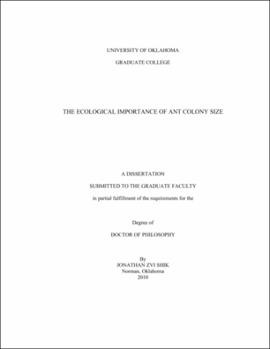| dc.contributor.advisor | Kaspari, Michael | |
| dc.creator | Shik, Jonathan Zvi | |
| dc.date.accessioned | 2019-04-27T21:31:21Z | |
| dc.date.available | 2019-04-27T21:31:21Z | |
| dc.date.issued | 2010 | |
| dc.identifier | 99264466202042 | |
| dc.identifier.uri | https://hdl.handle.net/11244/318897 | |
| dc.description.abstract | Despite the rich diversity of life, all organisms are unified by the conserved biochemical pathways that drive metabolism and govern the rate at which resources are processed and used to perform biological work. Metabolic rate further scales as a positive decelerating function of body size, and biologists have long sought to explain why one allometry, with a slope of ¾, accounts for most of the variation in metabolic rate from unicells to whales. In my studies of ant colonies (colonies of individuals), I have extended scaling techniques long used to study unitary organisms (colonies of cells), plotting colony size as the independent variable instead of body size to test hypotheses about the costs and benefits of eusociality and the extent to which colonial and unitary organisms are unified by a shared metabolic currency. | |
| dc.description.abstract | Ants (Hymenoptera: Formicidae) rank among the planet's most ecologically dominant organisms, and owe much of their success to the organizational benefits of colony life. Like all organisms, ant colonies have life histories--they make decisions about when to reproduce and how much of a limited resource pool to allocate to reproduction. Unlike unitary organisms, colonies grow by producing sterile workers that care for developing brood, defend the nest, and harvest resources from the environment. Colonies reproduce when they allocate these resources to sexual alates that disperse, mate, and found new colonies. My research focused on the ecological and evolutionary forces shaping colony size at reproduction, which governs nearly every aspect of ant form and function, and which spans from 10-5 to 109 g across >14,000 ant species. I used comparative analyses to test hypotheses about colony life history evolution (Chapter 1), field experiments in a Panamanian rainforest to examine whether resource limitation constrains colony traits (Chapter 2), and respirometry experiments examining how worker traits impact both whole colony energy demands (Chapter 3) and agricultural production in fungus growing ant societies (Chapter 4). | |
| dc.description.abstract | A wide range of taxa exhibit allometries of reproductive effort--the trend towards decreasing fecundity as species mature at larger body sizes. Similar patterns have long been assumed for ants and theory has sought to explain evolutionary trends towards increasing colony size if workers in larger colonies yield relatively fewer alates for their work. The comparative analysis I performed in Chapter 1 was the first test of this assumption. I found that despite an allometry of reproductive number, species with larger colonies tend to package relatively equivalent biomass into relatively fewer alates, suggesting a classic size-number tradeoff. | |
| dc.description.abstract | Bergmann's Rule describes the positive trend in body size and latitude. Ant colonies exhibit a version of this relationship, with tropical forests containing, on average, the planet's smallest colonies. In Chapter 2, I used a variety of manipulative field experiments to test whether resource limitation constrains colony size and abundance in tropical ant communities. I found that added food stimulated microbial decomposition of leaf litter habitat rather than colony growth, and that colony densities increased only when I added both food and nest sites. These results suggest that tropical litter ants are simultaneously limited by the availability of food and patchy leaf litter that becomes increasingly ephemeral when saturated with food. | |
| dc.description.abstract | Across ant species, worker metabolism is governed by the classic metabolic allometry reflecting lower mass-specific metabolic demands with increasing size. | |
| dc.description.abstract | However, little is known about whether this allometry also applies to larger workers within colonies. If larger workers are energetically cheaper to maintain, gram for gram, they may provide savings to their colonies by using relatively little energy not only when performing specialized tasks, but also when resting. In Chapter 3, I used respirometry experiments to link whole colony energy demands with worker size, using large major and small minor castes from three species in the genus Pheidole from Oklahoma grasslands. I found that behaviorally specialized Pheidole majors may save their colonies energy not only through task performance, but also because of maintenance costs that scale allometrically with both body and group size. | |
| dc.description.abstract | The rise of fungus cultivation in the ant tribe Attini has been called one of the major breakthroughs in animal evolution and provides striking parallels with human agriculture. In Chapter 4, I used respirometry experiments to examine the energetic costs and benefits of attine fungal cultivation, and test whether energetic efficiencies accompanied an evolutionary trend towards larger, more complex societies with increasingly domesticated cultivars. I found that fungi dominate colony energy demands because their mass far exceeds that of their ant farmers. In addition, although domesticated cultivars of more derived attines do more metabolic work for greater agricultural returns, energetic economies of scale suggest that larger colonies net greater fungal production from relatively less metabolic work. This metabolic allometry appears to favor the evolution of larger agricultural systems, and lays the groundwork for the evolution from basal attine species with < 100 workers to the derived 1 million worker superorganisms of the genus Atta. | |
| dc.format.extent | 173 pages | |
| dc.format.medium | application.pdf | |
| dc.language | en_US | |
| dc.relation.requires | Adobe Acrobat Reader | |
| dc.subject | Ant communities | |
| dc.subject | Ants--Ecology | |
| dc.subject | Ants | |
| dc.title | The ecological importance of ant colony size | |
| dc.type | text | |
| dc.type | document | |
| dc.thesis.degree | Ph.D. | |
| ou.group | College of Arts and Sciences::Department of Biology | |
